|
|
|||
|
(Back to Preceding Week; on to Next Week) |
|
NOTE 1: We spent more than four weeks banding hummingbirds in Costa Rica in early 2009. The following account is for Week Three. Reports are now posted for Week One, Week Two and and a follow-up Summary Report of 2009; we recommend you read the accounts in chronological order to better understand the whole sequence of events. Every week was different, so we hope you enjoy all the summaries. NOTE 2: A least four more nine-day Operation RubyThroat hummingbird expeditions are scheduled for January-March 2010 to Central America (Costa Rica and--for the first time--Guatemala and Belize). For more information see 2010 Tropical Hummingbird Banding Expeditions and contact EDUCATION.) HUMMINGBIRDS IN COSTA RICA: All eight members of our Beta Niners group flew out of the Liberia airport on 11 February 2009, satisfied they had made valuable contributions to Operation RubyThroat despite several days of high winds that stymied initial efforts. (See our on-line Beta Niners report for 3-11 February.) Susan and Ela were no newcomers to Operation RubyThroat or field work in Guanacaste; both had participated as Pioneers during our very first hummingbird banding expedition to Costa Rica in December 2004, and we were glad to have them along as Week Three was about to begin in 2009. Following lunch everyone headed back up the mountain to Buena Vista Lodge, with Susan and Ela expressing amazement all along the way at the amount of damage the previous week's windstorms had done to buildings and vegetation. That evening and the day following (12 February) were devoted to strolling around the Lodge, washing bird bags, inputting banding data, and just chillin', All text, maps, charts & photos © Hilton Pond Center
All text, maps, charts & photos © Hilton Pond Center DAY ONE (13 Feb), GAMMA NINERS: The Omega Niners (plus significant others) arose on Friday the 13th, ate breakfast, and headed back down the slopes of Rincon de la Vieja toward Liberia, intent upon getting to the airport in time to meet up with the final incoming group--the Gamma Niners--of whom there were 13 lucky members. Along the way we asked Guillermo "Whiskers" Hernandez (above), our always helpful driver and die-hard Bob Marley fan, to steer his bus across the bridge at Cañas Dulces and into the Aloe Vera fields beyond. From Cañas Dulces Whiskers took us to examine the bloom status at Carrington, where Week Two's Beta Niners had seen an almost unbelievable expanse of yellow flowers. Unfortunately, we found high winds that pummeled the region during the second week had dried out the aloe blossoms at Carrington; what had been a sea of yellow was now a vast stand of dead, brown flower stalks. With all this in mind, it was pretty obvious AV5 should be where the incoming group would set up nets. From the aloe fields it was off to the airport where all 13 Gamma Niners showed up on time; most came by plane, but our Canadian contingent flew in days earlier and came to the airport by taxi. The new group included Cheryl & Doak Ewing (Naperville IL), Rosalyn Fleisher (Rockville MD), Judy Gordon (Reston VA), Rita Heath & Donna Hummelman (Rock Hill SC), Mary Kimberly & Gavin MacDonald (Decatur GA), After loading luggage and themselves into the bus the Gamma Niners took a short drive from the airport to nice new open-air restaurant (above left), where they dined on traditional Costa Rican fare. Then everyone headed up toward Buena Vista Lodge to check in, watch the first group sunset (below), attend an evening orientation meeting, and spend a relatively calm night--or at least one with far less wind than Beta Niners had experienced during Week Two.
All text, maps, charts & photos © Hilton Pond Center DAY TWO (14 Feb), GAMMA NINERS: The Gamma Niners rose before dawn on Valentines Day, kissed and hugged their spouses (if present), had a hot breakfast, and boarded the bus for their first trip down the mountain for field work. As we had done with the Alpha Niners and Beta Niners, we took the new group to the first Aloe Vera field (AV1), where they were not pleased at finding a near-absence of yellow flowers. They also weren't too happy the power company had chopped down the special creekside Jocote tree that had been the site for hummingbird trapping during the winter of 2004-05. As we drove through the rest of the Cañas Dulces aloe plantation, the group saw and agreed the fifth Aloe Vera Field (AV5) did have the most blossoms and would be the logical place to erect mist nets. (Having scouted the Carrington fields and finding no aloe flowers, we Omega Niners didn't mention that particular site to the group--electing instead to take them there later in the week.)
All text, maps, charts & photos © Hilton Pond Center After some basic instruction the Gamma Niners went to work, pounding four-foot lengths of rebar into the ground, sliding net poles over the rebar, and unfurling several nets in newly established net lanes the northern section of AV5. This plot (AV5N, above) was hillier than the level southern section--now called AV5S--in which previous groups had worked. AV5N was in full sun and had no "edge" but contained a good many aloe blooms. We could also see several Ruby-throated Hummingbirds, Archilochus colubris, taking nectar throughout the plot and we were betting we could catch a few. The Gamma Niners did a fine job setting up on their first day in the field and had the first nets in place by about 9:15 a.m. We captured the first two ruby-throats at 9:20 a.m. and two more within the next 15 minutes. Things went amazingly well that morning--so well we went half an hour past our usual 11:30 a.m. shut-down time. The last bird captured hit the net at 11:50 a.m. and brought the day's total for AV5N to an incredible 21 Ruby-throated Hummingbirds--the second-best one-day total so far for any of our nine Costa Rican banding groups! (Crazy '08s Omega holds the record with 25 RTHU banded in AV4 over a three-hour span on 7 February 2008.) The Gamma Niners' first-day tally included a surprising eight adult males, plus two second-year males with incomplete red gorgets and 11 adult females--all in all a pretty nice Valentine present for everyone.
All text, maps, charts & photos © Hilton Pond Center DAY THREE (15 Feb), GAMMA NINERS: After a night of moderate windiness--we warned them to bring earplugs!--the Gamma Niners headed down the mountain on 15 February full of enthusiasm after the previous day's success in AV5N. Using the same lanes, they erected nets efficiently but were somewhat surprised at how much slower the hummingbird action turned out to be. It was nearly 75 minutes until we caught the first hummer and only five more hit the nets by shut-down time at 11:30 a.m. The day's total was six--less than one-fourth what we'd caught the day before--and included three adult males, a second-year male, and two adult females. One male (above) had a particularly showy throat; Ernesto snapped several photos because he said it was the brightest gorget he'd seen among nearly 50 adult male RTHU we've banded during five years in Costa Rica.
Although Ruby-throated Hummingbirds are by far the most commonly netted species in the aloe fields, we also net other Neotropical migrants--as well as nonmigratory birds. Among those are seven resident hummer species, of which the sexually monomorphic Cinnamon Hummingbird, Amazilia rutila (above), is one we have in-hand relatively often.
DAY FOUR (16 Feb), GAMMA NINERS: The third day of banding in AV5N (16 February) was almost a carbon copy of the previous day: Nets open by 7 a.m., no captures for 75 minutes, and again a final tally of six Ruby-throated Hummingbirds--all banded by 10:15 a.m. Among those were four second-year males and two adult females. After two consecutive days with just six birds in AV5N we pondered moving the nets to a different location when netting was to resume two days following. We banded one other migratory Neotropical species on 16 February, a Tennessee Warbler. Group members--and especially the trip leader--were saddened this day when Susan Hilton boarded Whiskers' bus and headed toward the airport Liberia for many hours of travel back to Hilton Pond Center and a next-morning return to her guidance counselor duties at York Comprehensive High School.
All text, maps, charts & photos © Hilton Pond Center Everyone cheered up considerably when Whiskers came back from the airport run because it was time to climb aboard the bus for a field trip to nearby Santa Rosa National Park, perhaps the best example of tropical dry forest--both evergreen and deciduous--in Costa Rica. After a box lunch and a good look a myriad of epiphytes festooning one of the park's big trees, the group wandered through the old hacienda at Santa Rosa--site of a famous 1856 battle that assured Costa Rica's independence. The restored building houses a small museum and is always of interest because it's home to at least two species of bats--neither of which we've been able to identify. Behind the Santa Rosa hacienda is a lookout tower that we climbed to--just in time to look skyward and see the Delta jet carrying Susan Hilton as it was gaining altitude on its way northward across Nicaragua and eventually to Miami. From the lookout we could also look east across a vast valley toward Rincon de la Vieja; with spotting scope we could actually pick out the roof of El Mirador, the place from which we always watch the sunset at Buena Vista Lodge. After descending the Santa Rosa lookout we re-boarded the bus and headed for Junquillal Beach to see if there were still any of those pesky jellyfish that had interfered with swimming by our first two groups.
All text, maps, charts & photos © Hilton Pond Center When we got to the beach it was almost deserted--by now Costa Rica's schools were back in session after a three-month mid-winter break--so families were no longer on vacation. The lack of people may have been why we saw more wildlife than ever before at this important protected coastal area. In particular we found lots of birds, including two species of owls, several parrots and parakeets, shorebirds, frigatebirds, pelicans, jays, DAY FIVE (17 Feb), GAMMA NINERS: Everyone got to sleep in a little on 17 February--the "hump day" we initiated this year in the middle of each week to give participants a breather from early mornings and fairly intense field work. The off day also provided opportunity for the Gamma Niners to take advantage of numerous amenities offered at Buena Vista Lodge. Folks used the morning to explore new corners of the 2,000-acre compound, birding and snapping photos of local flora and fauna.
All text, maps, charts & photos © Hilton Pond Center After lunch most of the group elected to ride horseback (above) to the volcanic spa, where subterranean gases seep toward the surface and heat a mixture of mud that feels sublime when applied to bare skin. The problem is that when slathered with mud one may look strange and undignified to folks who are not similarly adorned. For example, Dr. Mary Kimberly and her spouse Dr. Gavin MacDonald (below)--both of whom have advanced degrees in chemistry--were respected professionals until someone posted this photo depicting them as Queen & King of the Jungle.
DAY SIX (18 Feb), GAMMA NINERS: After diminishing returns over three days in AV5N--captures went from 21 ruby-throats the first day to six on each of the next two days--we elected to move our nets slightly south into AV5S. This field was quite productive in previous years and during Week One prior to when workers cut down the edge vegetation.
All text, maps, charts & photos © Hilton Pond Center From their somewhat higher vantage points in AV5N (above) the Gamma Niners could see most hummers there had figured out the mist net configuration and were foraging instead in more southerly sites. Thus, on 18 February we set our nets in lanes that wound around the perimeter of AV5S . . . and the strategy worked. By 7:25 a.m. we had our first hummer and between then and the 11:15 a.m. shutdown we netted a total of 17 new Ruby-throated Hummingbirds. Males were scarce, with just one partially gorgeted second-year bird and two adults; the remaining 14 were all "adult" females. (Unlike males, female ruby-throats always have white gorgets and therefore are much more difficult to age.) We banded one other migratory Neotropical species banded on 18 February, a Blue Grosbeak.
All text, maps, charts & photos © Hilton Pond Center After getting back to Buena Vista Lodge, eating lunch, and--in some cases--taking a short siesta--the Gamma Niners decided a group Canopy Walk would be a nice way to spend the latter part of the afternoon. This is always an exciting diversion, in which participants ascend into the canopy on metal mesh footbridges (above) suspended among the tallest trees.
All text, maps, charts & photos © Hilton Pond Center It's not a great idea to do this on windy days, but when things are calm it's a nice way to get eyeball-to-eyeball with birds, reptiles, and other animals that can be hard to see at ground level. Things were relatively quiet on this particular day, but being 60 feet off the ground and looking down at the shrub and understory layers was both exciting and exhilarating. A magnificent Malachite butterfly, Siproeta stelenes (above), brightened the scene as it landed for a moment on a sun-dappled leaf. DAY SEVEN (19 Feb), GAMMA NINERS: Considering our initial success in AV5S, the group decided to try again at that site on 19 February and was not disappointed with the outcome. After yielding 18 hummers on the 18th, the nets snared 20 more ruby-throats on the Gamma Niners' fifth day of field work. Again the captures were predominantly adult females--15 to be exact--with four second-year males and one adult. We also netted and banded two migratory Indigo Buntings.
All text, maps, charts & photos © Hilton Pond Center From Carrington we went for our highly anticipated afternoon in Liberia--complete with lunch at the Chinese restaurant, where several Gamma Niners took our recommendation and were not disappointed when they ordered and consumed grande platters of Red Snapper. We had some bonus entertainment, too, because the town was in the midst of its annual "Liberia Days" celebration--complete with a giant wooden marimba played by three people (above), mounted horsemen on parade, cattle in the streets, and traditional dancing by folks in costumes (below) with oversized, papier-mache heads. (Note the human peering through the white mesh just beneath the devil head.) After enjoying the music and exploring Liberia for a couple of hours--shopping!!!--the group rendezvoused at Whiskers' bus and headed up toward Buena Vista Lodge for yet another spectacular sunset.
All text, maps, charts & photos © Hilton Pond Center DAY EIGHT (20 Feb), GAMMA NINERS: On 20 February, their final day in the field, the Gamma Niners were eager to capture as many hummers as possible; they succeeded by rounding out the week with 14 more ruby-throats--all adult birds (ten females and four males). This brought their amazing six-day total to 84 birds--surpassing the old record of 77 Ruby-throated Hummingbirds caught by the Crazy '08s Omega last year during six days in the field. The Gamma Niners spent about four hours per day running mist nets, so that meant they were averaging more than three birds per hour--about as many as we could keep up with at the banding table!
All text, maps, charts & photos © Hilton Pond Center The Gamma Niners' last field day brought another special bird we had never handled or banded--a second-year Western Kingbird, Tyrannus verticalis (above and below). As its name implies this yellow-bellied flycatcher with a hidden red crown breeds across the western half of the U.S.; it's an uncommon winter resident along Costa Rica's Pacific Coast. Sometimes confused with the very similar but somewhat longer-billed Tropical Kingbird, T. melancholicus, it is best identified by white outer rectrices and a squared-off tail--characters not present in its close relative. On 20 February we also banded an Orchard Oriole and one more Indigo Bunting.
All text, maps, charts & photos © Hilton Pond Center From the aloe field we went to "The Wall," a vertical cliff face carved by a small river we passed over each day going from and to Buena Vista Lodge. Several Gamma Niners were curious about what sorts of things could be found in this interesting locale and navigated the tricky climb from road to riverbank.
All text, maps, charts & photos © Hilton Pond Center This fascinating habitat--perhaps 10-15 degrees cooler than the roadside--was much damper than most of Guanacaste, and the vegetation proved it. The lower portion of the cliff face was covered by water-loving mosses, liverworts, ferns, and flowering gesneriads while the upper portions supported drought-tolerant lichens and orchids. For camera buffs such as Gisele Normand (above)--who was about to return to sub-freezing temperatures in her Alberta, Canada homeland--the Wall was a pleasant place to linger while taking tons of photographs. From the Wall we again made our way to Buena Vista Lodge, the sunset, and an evening farewell celebration. (Click on image above to open a larger photo in a new browser window) DAY NINE (21 Feb), GAMMA NINERS: As the Gamma Niners got up and exited their cabins on 21 February, many expressed disbelief that their nine-day hummingbird banding expedition to Guanacaste Province was coming to a close so soon. Several of them hurried off to El Mirador for one more look at the Pacific Ocean in the distance while others made a last swing around Buena Vista Lodge to see if they could find any new bird species. After breakfast everyone boarded the bus one last time. On the way down the mountain we asked Mary Kimberly (below right, in clean T-shirt sans volcanic mud)--the official Week Three list-keeper--to call out names for all birds observed by the group during their time together in Costa Rica. Shortly after saying their good-byes, the Gamma Niners checked in at Liberia airport for their flights home and Whiskers aimed his bus toward San Jose. With him was Ela, who had been a great help during Week Two as a net tender (at left, below). Her experience in removing birds from the mist nets made Ernesto's job quite a bit easier and left him rested for follow-up field study that included four more days capturing hummingbirds as part of the Omega Niners. Descriptions of that additional work, summaries of our 2009 Costa Rica hummingbird banding, and insights on the importance of Aloe Vera fields for Neotropical migrants are the topics for our fourth and final report--to be posted as soon as we can get it all together.
All text, maps, charts & photos © Hilton Pond Center We'd be remiss if we didn't acknowledge all the conscientious hard work the 13 Gamma Niners performed during their six days within the Aloe Vera plantation at Cañas Dulces. Although several participants were involved in their first-ever field study, the group's collective initiative and diligence--coupled with keen observational skills--enabled us to determine the best places to run nets. All that helped make Week Three the most productive of all nine of our Costa Rica hummingbird expeditions to date. Our first two groups this year--the Alpha Niners and Beta Niners--had significant accomplishments under unusual and sometimes trying circumstances, from unexpected clear-cutting of edge plants to the windstorm of the century. For the Gamma Niners, however, the "third time was a charm." All text, maps, charts & photos © Hilton Pond Center NOTE: Please scroll down for a summary of results from Week Three, a running total of Ruby-throated Hummingbirds banded in 2009, and a scrapbook of Gamma Niner photos. GAMMA NINERS GROUP (Week Three) RESULTS As shown in Table 1 (below), during Week Three female RTHU again outnumbered males by more than two-to-one.
As shown in Table 2 (below), when banding totals from the Alpha Niners, Beta Niners, and Gamma Niners are combined with the one-day, 20-bird production by the Omega Niners, the ratio remains heavily on the side of females.
The three-group combined effort--supplemented by 20 birds caught on 2 February by the Omega Niners--brought the 2009 total to 190 Ruby-throated Hummingbirds banded; this surpassed the previous high of 170 set in 2008. The 2009 figure does not include several days of additional banding work by the Omega Niners after the Gamma Niners departed Costa Rica; their work and the season totals will be included in a cumulative summary in next week's installment of "This Week at Hilton Pond." All text, maps, charts & photos © Hilton Pond Center GAMMA NINERS SCRAPBOOK We hope you'll enjoy the following images of people, places, plants, and wildlife, taken during Week Three of our 2009 hummingbird banding expeditions to Costa Rica.
All text, maps, charts & photos © Hilton Pond Center Among the many pigeons and doves in Costa Rica, the pink-and-black bill and multicolored eye of the Common Ground-Dove, Columbina passerina, are diagnostic characteristics.
While the Gamma Niners were running nets and watching hummingbirds, Guillermo "Whiskers" Hernandez was usually servicing his bus in the shade--whether it be replacing a faulty headlight (above) or washing it down with buckets of water hauled from a nearby stream. All text, maps, charts & photos © Hilton Pond Center
All text, maps, charts & photos © Hilton Pond Center One thing folks like best about our Operation RubyThroat expeditions is that after working hard catching hummingbirds all morning everyone gets the afternoon to explore. And to top off the day everyone gathers at El Mirador before supper to chat and enjoy the sunset.
The Black Iguana, Ctenosaura similis, occurs throughout Guanacaste Province and is seen most frequently: 1) sunning itself; or, 2) Crossing the road and impeding vehicular traffic. The female above was resting on the branch of a huge tree at Santa Rosa National Park, all the while keeping an eye on the big male (below) displaying nearby.
All text, maps, charts & photos © Hilton Pond Center The male Black Iguana is larger and more heavily built than his prospective mate, with a big dewlap (throat pouch) he exhibits while raising his head and baring his teeth.
All text, maps, charts & photos © Hilton Pond Center Alog with iguanas, the big trees at Santa Rosa National Park support an amazing assemblage of epiphytes--non-parasitic plants that live on the branches but make their own food via photosynthesis. In the photo above, the big spiny clumps are Bromeliads while the pencil-like cluster at lower left is an orchid.
All text, maps, charts & photos © Hilton Pond Center Cacti are also epiphytic on Santa Rosa's mature trees. The one above--Strawberry Pear, Hylocereus undatus--produces something called "Dragon Fruit" that is eaten raw or dried into fruit leather. Also pictured is a female Hoffman's Woodpecker, Melanerpes hoffmannii, a Costa Rican counterpart for the Red-bellied Woodpecker, M. carolinus, that occurs across eastern North America.
All text, maps, charts & photos © Hilton Pond Center Feeding in the treetops at the Santa Rosa lookout tower was this Crested Guan, Penelope purpurascens, a mostly arboreal turkey-sized bird that makes a living eating fruits, seeds, and leaves. Although shadows and backlighting make it appear almost black in the photo, this bird is actually dark greenish-brown, with a rusty rump and a bright red gular sac.
All text, maps, charts & photos © Hilton Pond Center The shoreline and coastal forest at isolated Junquillal Beach had much more wildlife during Week Three, possibly because Costa Rican schools had reopened and vacationers were few. This American Oystercatcher, Haematopus palliatus, was the first we had seen in nine visits to the beach.
All text, maps, charts & photos © Hilton Pond Center In the trees at Junquillal Beach we observed an eight-bird flock of White-fronted Parrots, Amazona albifrons. Most were eating flower petals. Parrots and parakeets occur throughout Guanacaste Province; the former have short, squared-off tails (as above), while parakeet are longer and pointed.
Snoozing--and squinting--in the bright coastal sun at Junquillal was this Pacific Screech-Owl, Megascops cooperi. This species was also common at Buena Vista Lodge (elevation 2,400 feet), where an entire colony often serenaded us on windless nights with a series of hup-hup-hup-hup-hup calls.
All text, maps, charts & photos © Hilton Pond Center One morning on the bus ride down the mountain from Buena Vista Lodge the group was fascinated by two Keel-billed Toucans, Ramphastos sulfuratus, hopping around excitedly in the canopy. An apparent mated pair, they were investigating a tree cavity that we suspect was about to become a nest site.
All text, maps, charts & photos © Hilton Pond Center Among everyone's favorite birds in Costa Rica was the long-tailed Turquoise-browed Motmot, Eumomota superciliosa. This is yet another species common to Guanacaste's dry forest but not found elsewhere in Costa Rica. The shorter-tailed, more widely distributed Blue-crowned Motmot, Momotus momota, also does not occur on the country's Caribbean side.
All text, maps, charts & photos © Hilton Pond Center Although Ruby-throated Hummingbirds DO dine on the nectar of non-native Aloe Vera when overwintering in Costa Rica, we're always watching to see what native flowers they also visit. This year we added Kapok, Ceiba pentandra, to the list. The flowers of this tree (above) open in the morning but lose their petals by lunchtime.
All text, maps, charts & photos © Hilton Pond Center Based upon audible and visible evidence, Rufous-naped Wrens, Campylorhynchus rufinucha, have to be the most common member of the Troglodytidae around our study sites. Even so, we seldom catch them in our mist nets. These boisterous little birds are everywhere in Guanacaste but are absent from the rest of Costa Rica. Like Carolina Wrens back in the U.S. this species often occurs around human habitations.
All text, maps, charts & photos © Hilton Pond Center Each year in the aloe fields we catch several hummingbirds that are NOT ruby-throats. Among these are sexually monomorphic Steely-vented Hummingbirds, Amazilia saucerrottei (above), which are iridescent green except for a rainbow-colored rump and a gun-metal blue tail.
All text, maps, charts & photos © Hilton Pond Center When we run mist nets, the welfare of birds we capture and handle is always foremost in our minds. To minimize the possibility of a bird getting overheated in a net, we instruct our group participants to cast shade on any snared bird until an experienced net tender can remove it. Here Cheryl Ewing uses her hat to keep a hummingbird cool.
All text, maps, charts & photos © Hilton Pond Center The banding table is a place for scientific investigation AND for education. Above, trip leader Bill Hilton Jr. examines a Ruby-throated Hummingbird as expert guide and colleague Ernesto Carman Jr. and Gamma Niners Rita Heath (left) and Gisele Normand (right, serving as data scribe) look on. The scribe's role is VERY important because that person makes sure all measurements and other data have been recorded properly. Every participant scribes several times and then gets to hold and release the hummingbird that was just banded (below).
Whenever we can we also involve Costa Ricans in our work; the tico wearing the cap in the banding table photo (above) was a local farmer named Juan. He was keenly interested in the banding process and was quite excited when we allowed him to hold and release a banded hummer. (You can have the same exciting and meaningful experience by joining an Operation RubyThroat tropical hummingbird expedition in 2010!)
All text, maps, charts & photos © Hilton Pond Center Another sunset from El Mirador, the incomparable lookout at Buena Vista Lodge. NOTE: A least four more nine-day Operation RubyThroat hummingbird expeditions are scheduled for January-March 2010 to Central America (Costa Rica and--for the first time--Guatemala and Belize). For more information see 2010 Tropical Hummingbird Banding Expeditions and contact EDUCATION.)
Comments or questions about this week's installment?
Thanks to the following fine folks for recent gifts in support of Hilton Pond Center for Piedmont Natural History and/or Operation RubyThroat: The Hummingbird Project. Your tax-deductible contributions allow us to continue writing, photographing, and sharing "This Week at Hilton Pond." (Please see Support if you'd like to make a gift of your own. You can also contribute by ordering an Operation RubyThroat T-shirt.)
"This Week at Hilton Pond" is written & photographed You may wish to consult our Index of all nature topics covered since February 2000. You can also use our on-line Hilton Pond Search Engine at the bottom of this page. For a free, non-fattening, on-line subscription to |
|
Make direct donations on-line via
Network for Good: |
|
|
Use your PayPal account
to make direct donations: |
|
|
If you like to shop on-line, you please become a member of iGive, through which more than 750 on-line stores from Barnes & Noble to Lands' End will donate a percentage of your purchase price in support of Hilton Pond Center and Operation RubyThroat. For every new member who signs up and makes an on-line purchase iGive will donate an ADDITIONAL $5 to the Center. Please sign up by going to the iGive Web site; more than 200 members have signed up to help. It's a painless, important way for YOU to support our on-going work in conservation, education, and research. |
|
|
SPECIES BANDED THIS WEEK: * = New species for 2009 WEEKLY BANDING TOTAL NONE THIS WEEK (in Costa Rica YEARLY BANDING TOTAL (2009) 11 species 293 individuals 28-YEAR BANDING GRAND TOTAL (since 28 June 1982) 124 species 52,175 individuals NOTABLE RECAPTURES THIS WEEK (with original banding date, sex, and current age) NONE THIS WEEK (in Costa Rica)
|
|
|
|
|
(Back to Preceding Week; on to Next Week) Up to Top of Page Back to This Week at Hilton Pond Center Current Weather Conditions at Hilton Pond Center |
 You can also post questions for The Piedmont Naturalist |
Join the |
Search Engine for |
|
|
$15 off coupon code

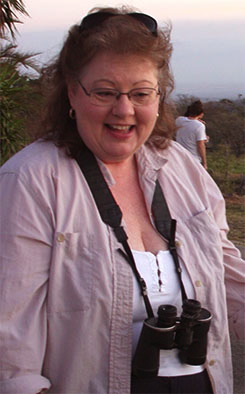 They were all thankful weather on fly-out day was calm and clear and so were we, for as Week Two folks departed the Omega Niners (i.e., trip leader Bill Hilton Jr. and expert guide and colleague Ernesto Carman Jr.) hung out at the airport awaiting the arrival of Susan Hilton (left); she was flying in from cold, wet, wintry South Carolina to spend Valentines Day--the Hiltons' 38th anniversary--with her spouse in warm, dry, sunny Costa Rica. Susan's plane touched down safely, there were plenty of hugs all around--after five years of working with the project plus a summer visit to Hilton Pond Center Ernesto is practically family--and the trio headed back toward Liberia for a late lunch at an open-air restaurant. There, by no small coincidence, we linked up with Ernesto's fiancee, Elaida "Ela" Villanueva Mayorga (below right), a talented and lovely tica naturalist who had come over from the Caribbean side with his sister Tina. It is Tina (now a real estate agent in Guanacaste on the Pacific side) and Ernesto's brother Cris whose names are immortalized by Finca Cristina--
They were all thankful weather on fly-out day was calm and clear and so were we, for as Week Two folks departed the Omega Niners (i.e., trip leader Bill Hilton Jr. and expert guide and colleague Ernesto Carman Jr.) hung out at the airport awaiting the arrival of Susan Hilton (left); she was flying in from cold, wet, wintry South Carolina to spend Valentines Day--the Hiltons' 38th anniversary--with her spouse in warm, dry, sunny Costa Rica. Susan's plane touched down safely, there were plenty of hugs all around--after five years of working with the project plus a summer visit to Hilton Pond Center Ernesto is practically family--and the trio headed back toward Liberia for a late lunch at an open-air restaurant. There, by no small coincidence, we linked up with Ernesto's fiancee, Elaida "Ela" Villanueva Mayorga (below right), a talented and lovely tica naturalist who had come over from the Caribbean side with his sister Tina. It is Tina (now a real estate agent in Guanacaste on the Pacific side) and Ernesto's brother Cris whose names are immortalized by Finca Cristina--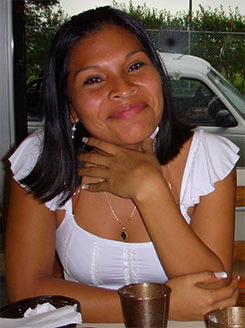 the fully organic, family-operated, shade-grown coffee farm at Paraiso, near San Jose. (See the
the fully organic, family-operated, shade-grown coffee farm at Paraiso, near San Jose. (See the 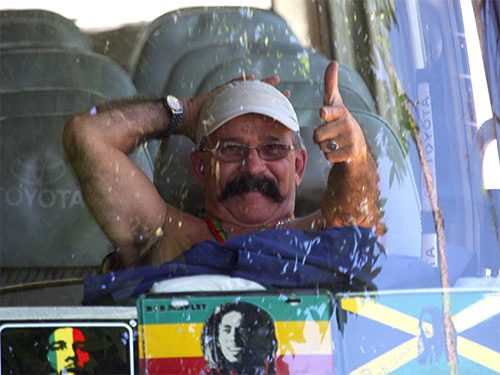
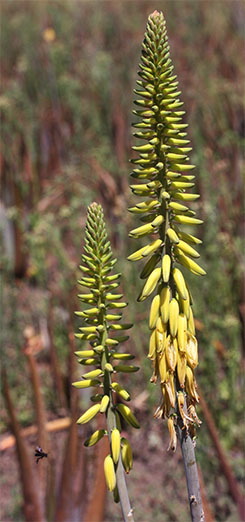 In that the Beta Niners had spent all their time last week running mist nets at Carrington Laboratories' Finca Sabila just south of Liberia, we were particularly curious if the Cañas Dulces aloe bloom had improved in AV5 over the past ten days. This was the field in which the Alpha Niners had worked with some success during Week One--at least until workers machete-cut most of the hummingbird flowers that surrounded that field--and it was important to know its current condition. Our morning scouting mission revealed AV5 had quite a few more blooms than during the preceding two weeks--especially in a northern section where we had not run nets previously. (See photo at right; also note in the bottom left corner a little black bee coming in to feed on aloe nectar.)
In that the Beta Niners had spent all their time last week running mist nets at Carrington Laboratories' Finca Sabila just south of Liberia, we were particularly curious if the Cañas Dulces aloe bloom had improved in AV5 over the past ten days. This was the field in which the Alpha Niners had worked with some success during Week One--at least until workers machete-cut most of the hummingbird flowers that surrounded that field--and it was important to know its current condition. Our morning scouting mission revealed AV5 had quite a few more blooms than during the preceding two weeks--especially in a northern section where we had not run nets previously. (See photo at right; also note in the bottom left corner a little black bee coming in to feed on aloe nectar.)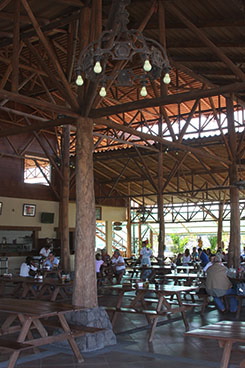 Catharine & Jim Lawhon (Polk City FL), and the three Canadians Gary & Sharon Lelliott (Castlegar, British Columbia) and Gisele Normand (Calgary, Alberta). Rita and Donna were aware of our tropical hummingbird research because they live in York County SC about ten miles from Hilton Pond Center; most other participants had seen us give Operation RubyThroat presentations in distant cities, heard about our Costa Rica work from trip alumni, or just happened to Google "hummingbirds" on the Internet. Gary knew because he's a hummingbird bander who, with Sharon, traps breeding and migrant Rufous, Calliope, and Black-chinned Hummingbirds at their home in western Canada.
Catharine & Jim Lawhon (Polk City FL), and the three Canadians Gary & Sharon Lelliott (Castlegar, British Columbia) and Gisele Normand (Calgary, Alberta). Rita and Donna were aware of our tropical hummingbird research because they live in York County SC about ten miles from Hilton Pond Center; most other participants had seen us give Operation RubyThroat presentations in distant cities, heard about our Costa Rica work from trip alumni, or just happened to Google "hummingbirds" on the Internet. Gary knew because he's a hummingbird bander who, with Sharon, traps breeding and migrant Rufous, Calliope, and Black-chinned Hummingbirds at their home in western Canada.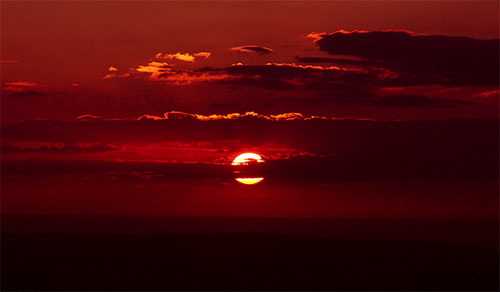
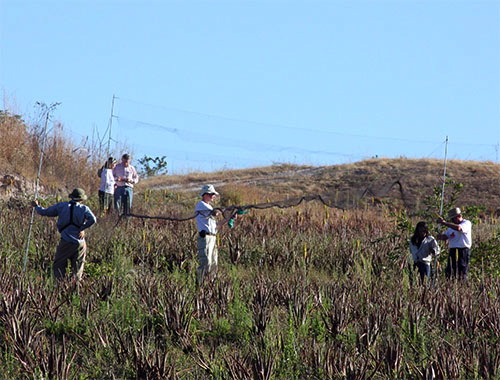
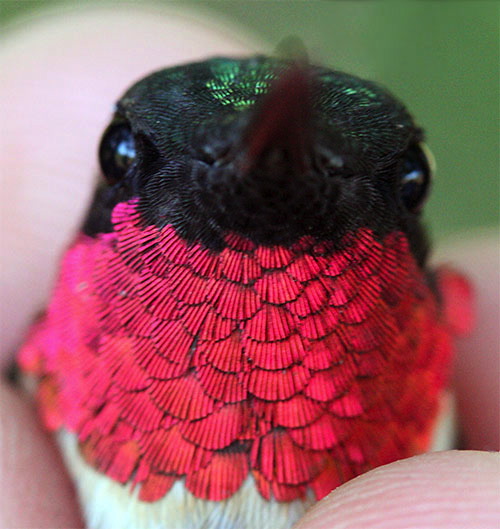
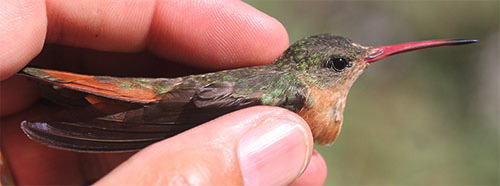
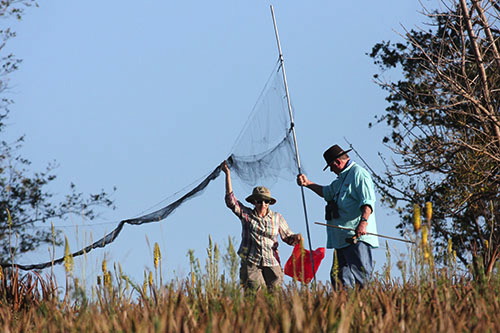
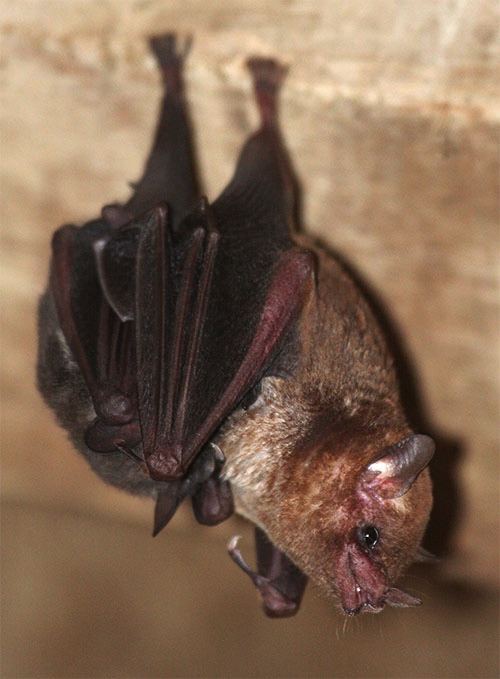
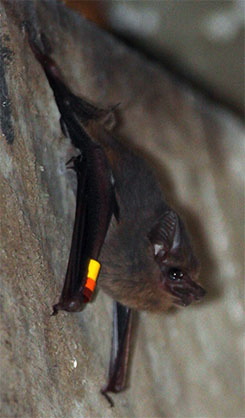 In the rafters we've previously seen one leaf-nosed variety (above, with a dark pup hidden under the female's wing), but this week we spotted several individuals of a different species--one of which had plastic color bands near its wrist (left). We're guessing this particular bat was tagged during one of many surveys and field research projects being conducted within the national park.
In the rafters we've previously seen one leaf-nosed variety (above, with a dark pup hidden under the female's wing), but this week we spotted several individuals of a different species--one of which had plastic color bands near its wrist (left). We're guessing this particular bat was tagged during one of many surveys and field research projects being conducted within the national park.
 and even a Gray-necked Wood-Rail (above; see the Beta Niners Scrapbook below for additional photos of wildlife from Santa Rosa and Junquillal Beach). And, by the way, since the jellyfish were gone the Gamma Niners got to dip and float (above left) in the placid but chilly waters of the Pacific Ocean.
and even a Gray-necked Wood-Rail (above; see the Beta Niners Scrapbook below for additional photos of wildlife from Santa Rosa and Junquillal Beach). And, by the way, since the jellyfish were gone the Gamma Niners got to dip and float (above left) in the placid but chilly waters of the Pacific Ocean.
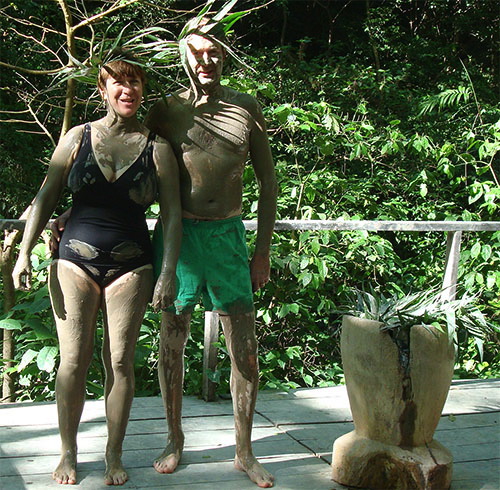
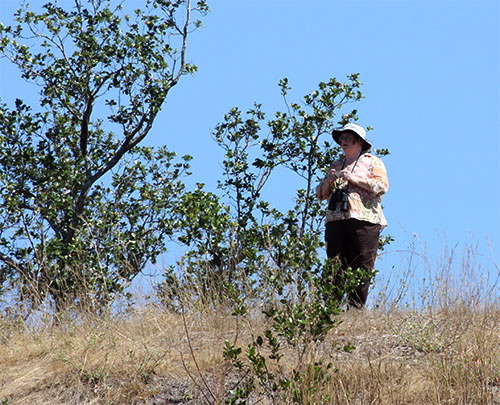
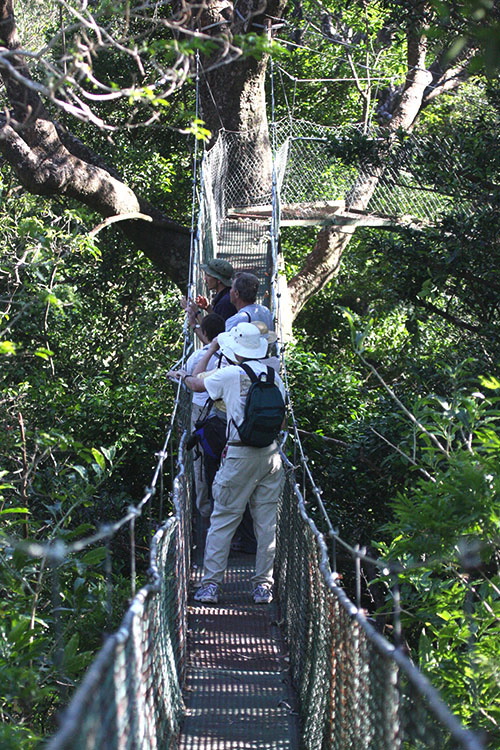
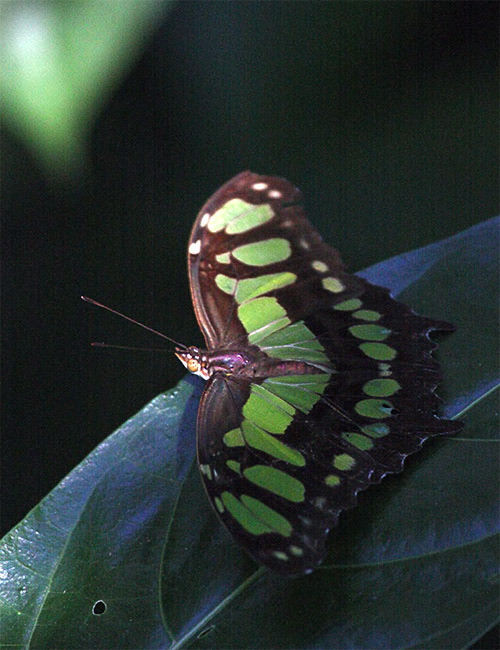
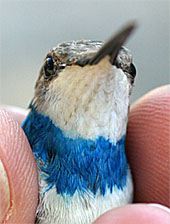 Following such a successful morning we departed the aloe fields at Cañas Dulces for our traditional afternoon in Liberia, but first we headed for Carrington Laboratories' processing facility just south of town. There we finally told our current group about the vast sea of yellow aloe flowers that had provided the Beta Niners with a different place in which to run mist nets. Considering that almost all the flowers had dried up and dropped off due to last week's wind, the Gamma Niners could hardly believe how productive the site had been less than ten days before. The group did see a few Ruby-throated Hummingbirds in the vicinity of Carrington, including one we had color-marked with two lines of blue dye to differentiate it from those we marked at Cañas Dulces with just one blue line (above left).
Following such a successful morning we departed the aloe fields at Cañas Dulces for our traditional afternoon in Liberia, but first we headed for Carrington Laboratories' processing facility just south of town. There we finally told our current group about the vast sea of yellow aloe flowers that had provided the Beta Niners with a different place in which to run mist nets. Considering that almost all the flowers had dried up and dropped off due to last week's wind, the Gamma Niners could hardly believe how productive the site had been less than ten days before. The group did see a few Ruby-throated Hummingbirds in the vicinity of Carrington, including one we had color-marked with two lines of blue dye to differentiate it from those we marked at Cañas Dulces with just one blue line (above left).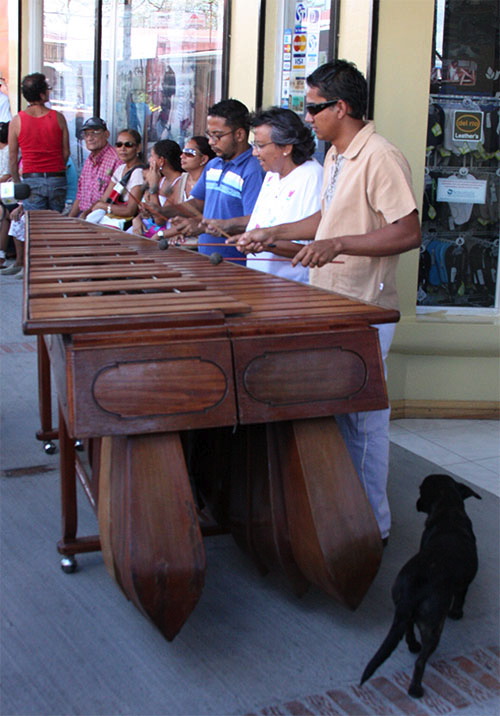
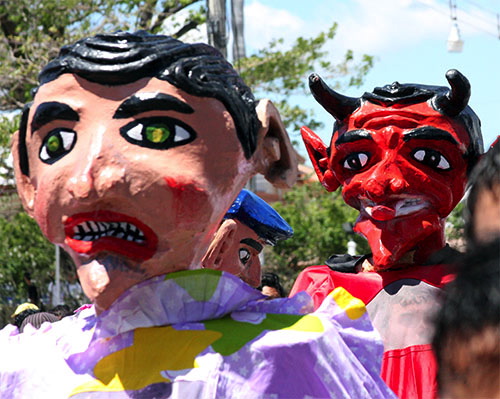
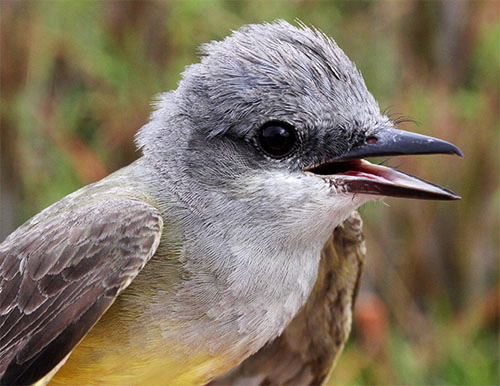
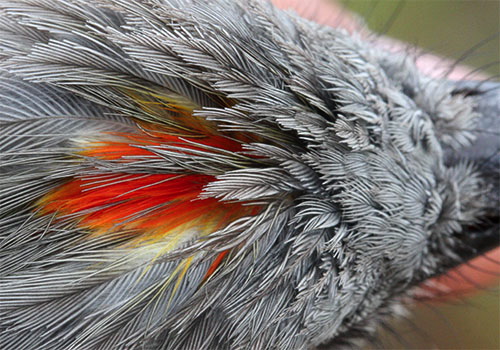
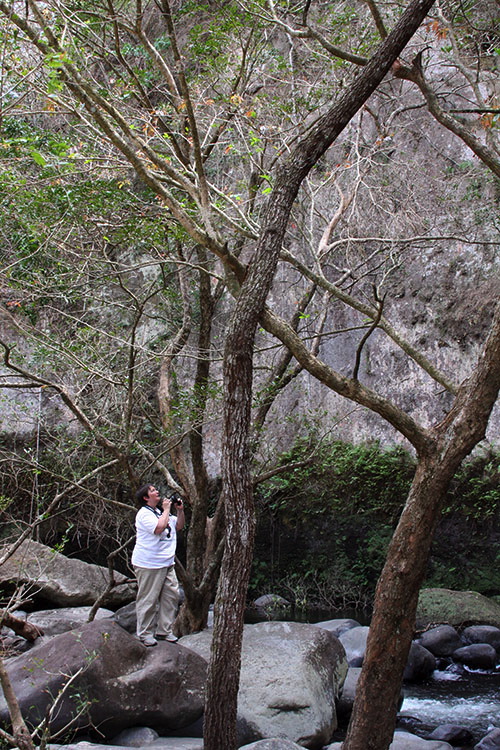
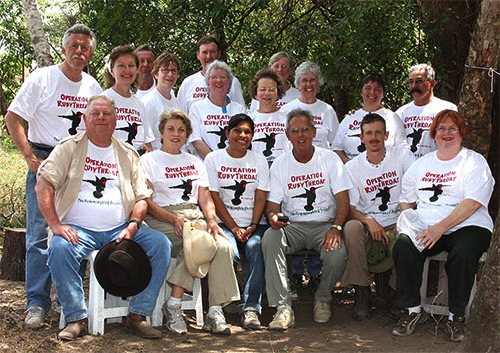
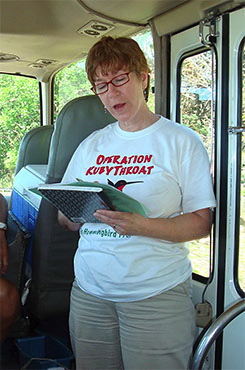 In all Mary read 90 species--a very nice total for the Gamma Niners. (Most groups get about 85 or so, as did the Alpha Niners this year; the Beta Niners tallied an all-time record of 121 species seen and/or heard.)
In all Mary read 90 species--a very nice total for the Gamma Niners. (Most groups get about 85 or so, as did the Alpha Niners this year; the Beta Niners tallied an all-time record of 121 species seen and/or heard.)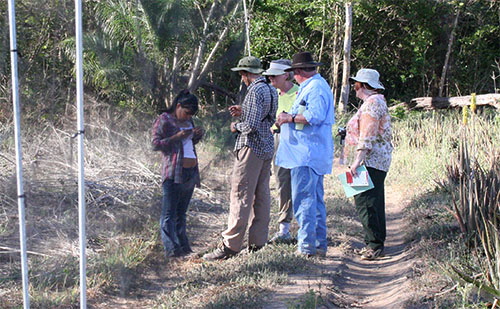
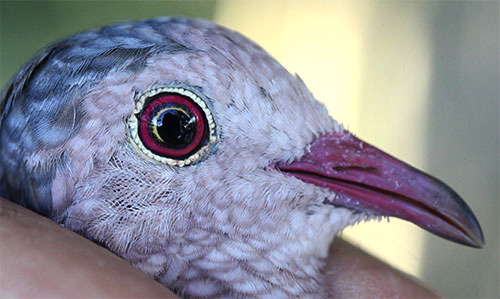
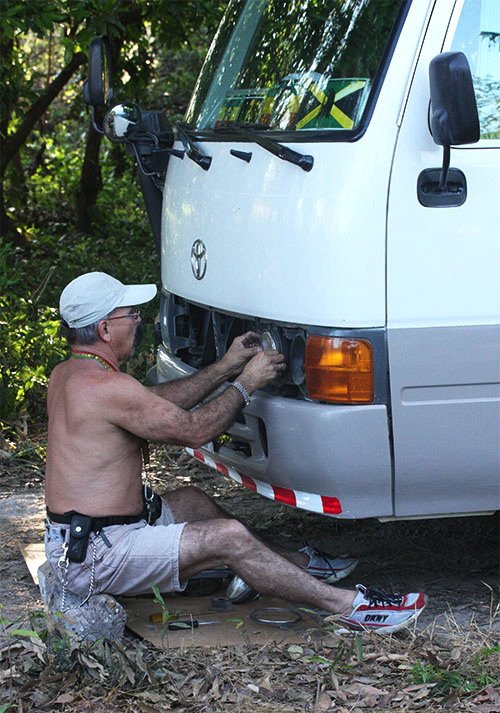
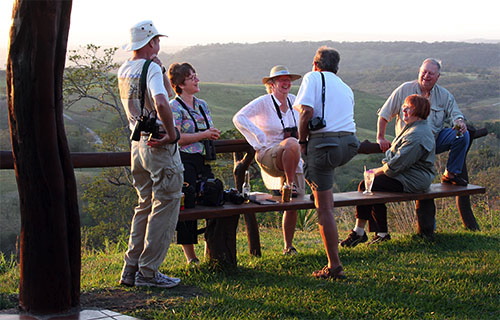
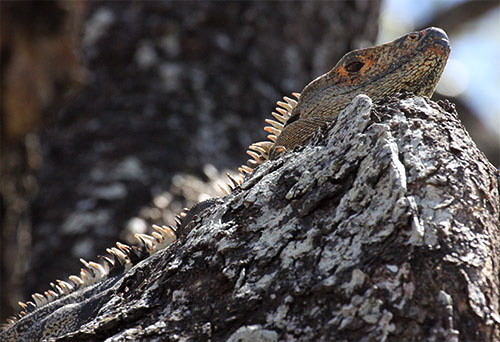
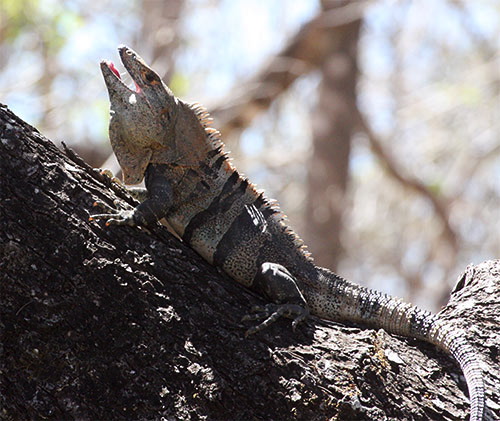

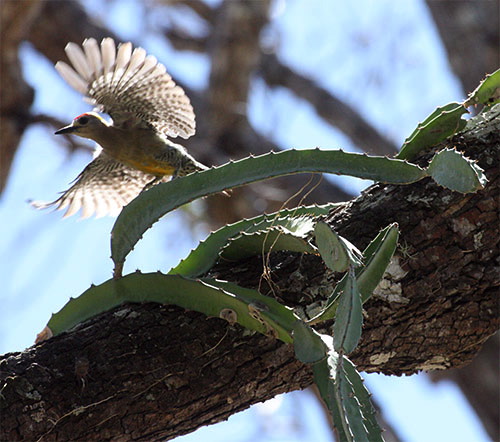
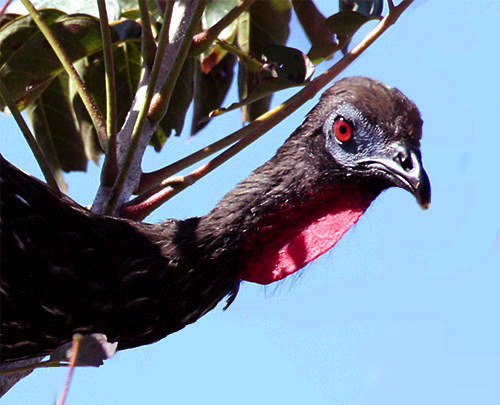
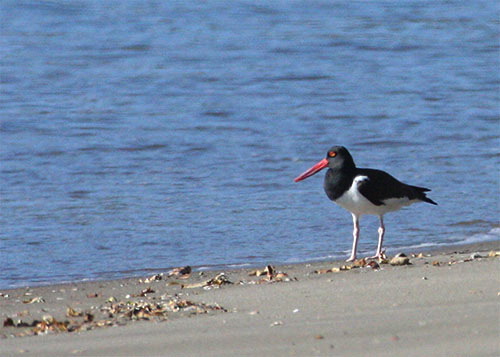
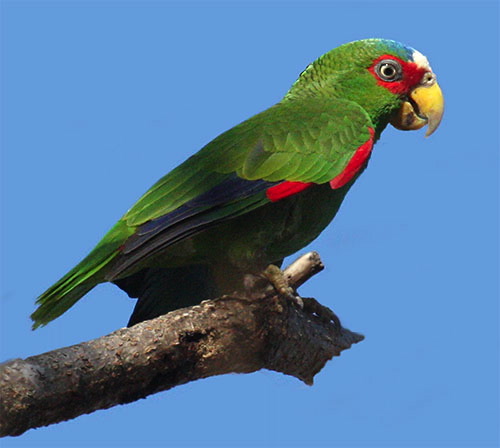
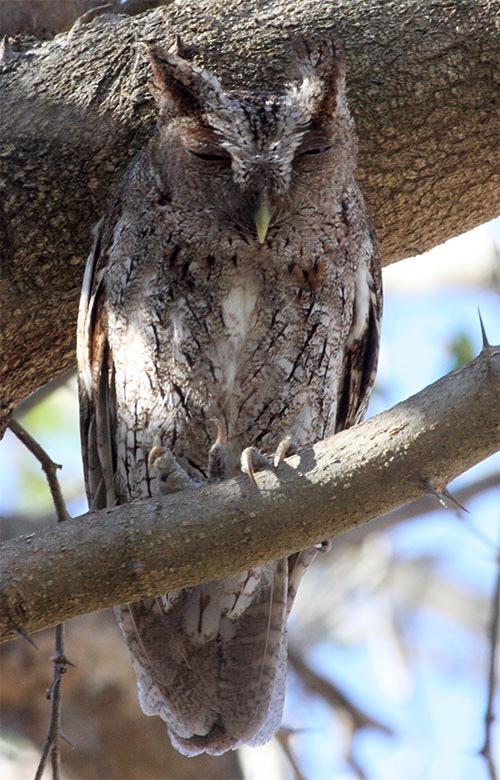
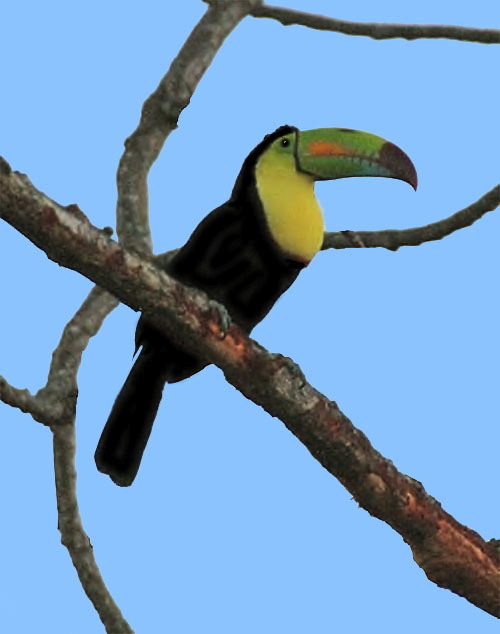
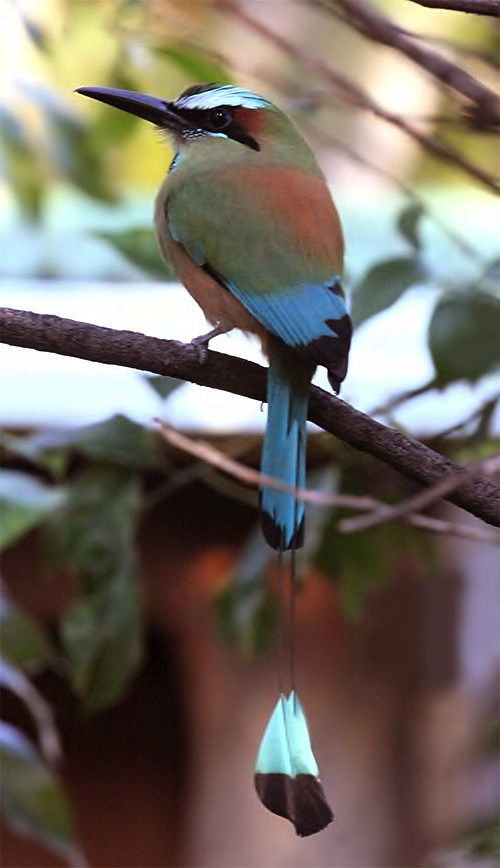
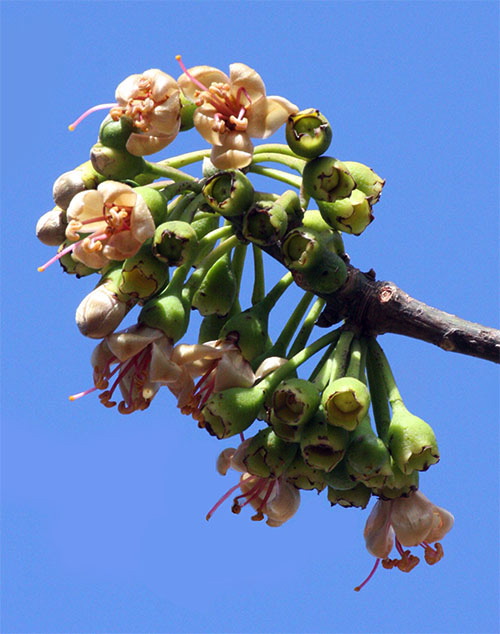

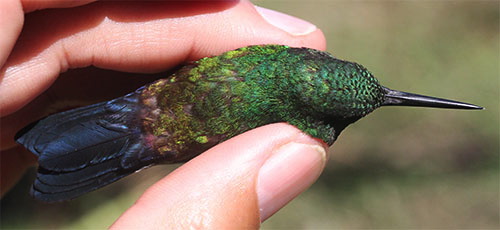
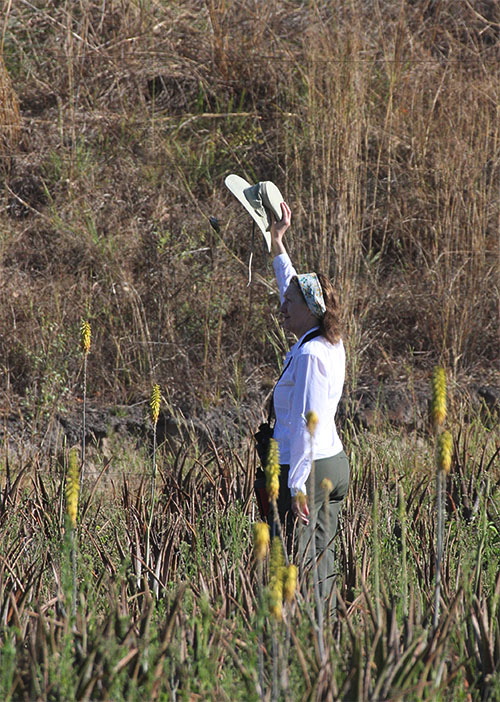
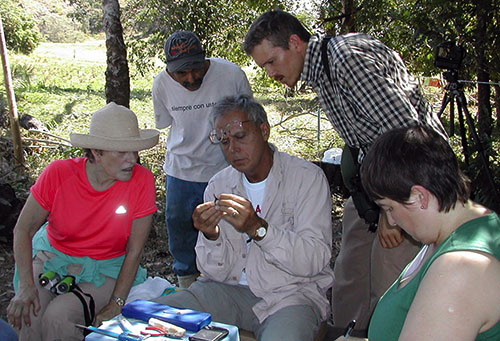
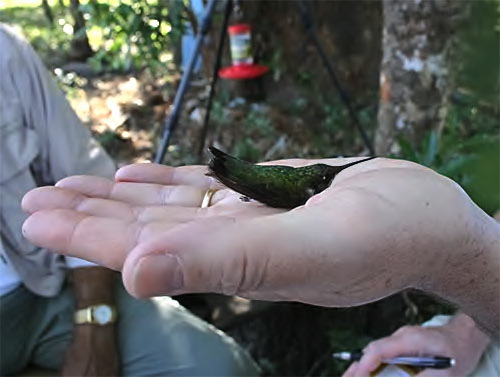
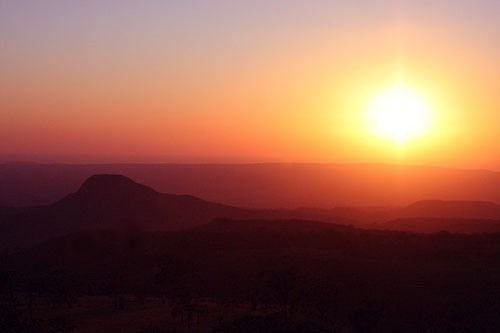


 Oct 15 to Mar 15:
Oct 15 to Mar 15: